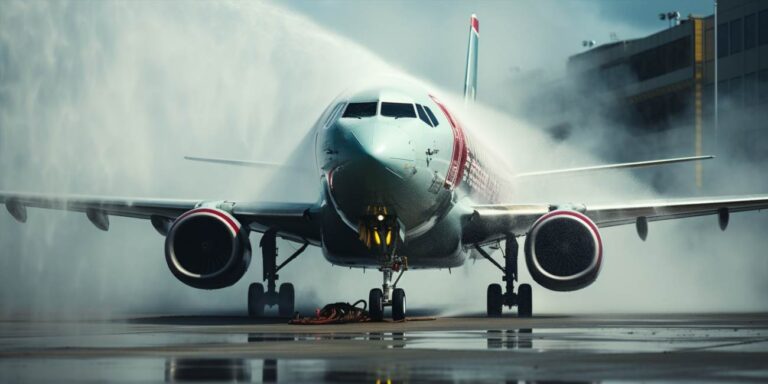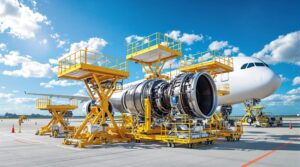Composed primarily of a mixture of glycol-based chemicals, these fluids serve a dual purpose – they prevent ice formation on critical surfaces and remove existing ice layers. The key components of these fluids include propylene glycol or ethylene glycol, both of which exhibit excellent thermal properties. These glycols lower the freezing point of the fluid, allowing it to stay in a liquid state at lower temperatures.
The primary purpose of aircraft deicing fluid is to create a protective barrier on the aircraft’s surfaces. During cold weather, these surfaces, such as wings, tail, and control surfaces, are susceptible to ice buildup. The application of deicing fluid forms a thin, protective film that inhibits the formation of ice, ensuring optimal aerodynamics and flight control.
There are two main types of deicing fluids: Type I and Type IV. Type I fluids are typically applied to remove existing ice, while Type IV fluids are more viscous and designed to provide longer-lasting protection against ice accumulation.
The application process involves specialized equipment at airports. Deicing trucks equipped with boom arms or sprayers evenly distribute the fluid across the aircraft’s surfaces. The choice between Type I and Type IV depends on the specific weather conditions and the expected duration of protection required.
It’s crucial to note that while aircraft deicing fluid is essential for safe winter operations, its use raises environmental concerns. Efforts are ongoing to develop environmentally friendly alternatives that maintain the fluid’s effectiveness while minimizing ecological impact.
Explaining how glycol-based aircraft deicing fluids work to prevent ice
Aircraft deicing fluids play a crucial role in ensuring the safety and functionality of airplanes during cold and icy conditions. One of the commonly used types of deicing fluids is based on glycol, a versatile and effective compound. Understanding how glycol-based aircraft deicing fluids work requires delving into the science behind their formulation and application.
The primary purpose of these fluids is to prevent ice formation on the surfaces of an aircraft, particularly on the wings and tail. Ice accumulation can significantly impact the aerodynamics of an airplane, leading to reduced lift and increased drag. To combat this, glycol-based deicing fluids are applied before takeoff to create a protective layer.
The active ingredient in these fluids is glycol, often in the form of ethylene or propylene glycol. This compound has a lower freezing point than water, making it effective in preventing the formation of ice. The deicing fluid is typically heated and sprayed onto the aircraft’s surfaces, forming a thin film that adheres to the metal.
One of the key mechanisms by which glycol-based deicing fluids work is by absorbing latent heat from the environment. As the glycol solution comes into contact with ice or snow, it absorbs heat from the surroundings, causing the frozen particles to melt. This heat absorption process is crucial in preventing further ice accretion on the aircraft.
The application of glycol-based deicing fluids is a time-sensitive process. Pilots and ground crews must ensure that the fluid is applied shortly before takeoff to maximize its effectiveness. The duration of protection provided by the deicing fluid depends on various factors, including temperature, precipitation rate, and the concentration of glycol in the solution.
It’s worth noting that while glycol-based deicing fluids are highly effective, they are not a permanent solution. Aircraft may need to undergo multiple deicing procedures during extended periods of cold weather or when exposed to freezing precipitation. Additionally, the environmental impact of glycol runoff should be considered, as excessive use can have implications for ecosystems around airports.
Discussing why propylene and ethylene glycol are used in aircraft deicers
When it comes to ensuring safe takeoffs and landings, runway and taxiway maintenance in cold weather is of paramount importance. Aircraft operating in freezing conditions face the constant threat of ice accumulation, which can compromise their performance and safety. To combat this challenge, aviation experts turn to specialized solutions, and two key players in the realm of aircraft de-icing are propylene glycol and ethylene glycol.
Deicing is the process of removing existing ice from the aircraft surfaces, while anti-icing involves the application of substances to prevent ice formation. Propylene glycol and ethylene glycol are chosen for these tasks due to their unique properties. These glycols are hygroscopic, meaning they attract and hold moisture, preventing ice from adhering to the aircraft’s surfaces.
Let’s delve into the specifics of why propylene glycol is a preferred choice in the aviation industry. This chemical compound has a lower freezing point compared to water, making it effective in sub-zero temperatures. Furthermore, its low viscosity allows for efficient spraying, ensuring a comprehensive coverage over the aircraft’s wings, fuselage, and tail.
Now, turning our attention to ethylene glycol, another stalwart in the fight against icy conditions. This glycol boasts excellent thermal stability, enabling it to withstand the temperature extremes encountered during high-altitude flights. Its use in aircraft de-icing solutions ensures that the protective coating remains intact even in severe cold weather.
One cannot overstate the significance of these glycols in enhancing runway and taxiway safety. Imagine a scenario where icy surfaces compromise an aircraft’s ability to brake or maneuver on the ground. The consequences could be catastrophic. However, with the strategic application of glycol-based de-icers, airports can maintain operational integrity even in the most frigid conditions.
It’s worth noting that the application of de-icing solutions involves a meticulous process. Airports utilize specialized vehicles equipped with sprayers to evenly distribute the glycol mixtures on the aircraft surfaces. This targeted approach ensures that the glycols form a protective layer, preventing ice accretion during critical phases of flight.
Examining application methods and removal procedures for aircraft deicers
When it comes to aircraft deicing, the application methods play a crucial role in ensuring the safety and efficiency of the process. One of the primary components in this operation is the nozzle, a small but indispensable device responsible for delivering the deicing fluid to the targeted surfaces of the aircraft.
The nozzle is strategically positioned on the hose, which acts as the conduit for the deicing fluid. This hose is connected to a specialized truck equipped with a large reservoir of deicing fluid. The truck serves as a mobile unit, allowing flexibility in reaching various aircraft on the tarmac.
During the application process, the nozzle plays a pivotal role in controlling the spray pattern. The deicing fluid, often a mixture of glycol and water, is expelled through the nozzle in a targeted spray, covering the critical surfaces of the aircraft. The precision of the nozzle ensures that the deicing fluid reaches all the necessary areas without wastage.
Efficient deicing not only involves proper application but also necessitates a systematic and effective removal procedure. After the deicing fluid has successfully melted the ice or snow on the aircraft surfaces, a careful removal process is initiated. The truck, equipped with powerful suction capabilities, plays a vital role in this phase.
The deicing truck is equipped with a specialized system for removing the melted ice and excess deicing fluid from the aircraft. The suction hose connected to the truck creates a vacuum effect, efficiently removing the liquid residue. This method ensures that the aircraft is left dry and free from any remnants of the deicing process.






